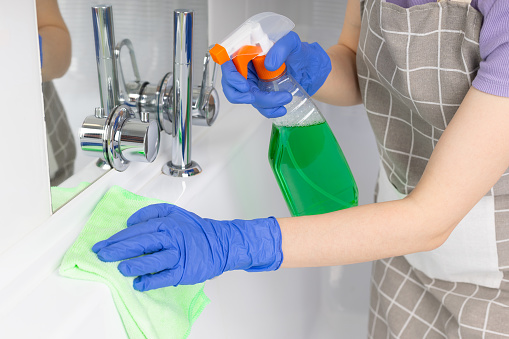There are few things more relaxing and replenishing than a warm bath.
Bathing can be more than a luxurious experience, it can also be good for you. The health benefits of relaxing in the tub are numerous and varied and backed by a number of scientific studies.
But before you take a dip into soapy relaxation, your own home bathtub could probably use a bit of a cleanup. Tubs quickly can collect the dirt, grime, and bacteria we leave behind on their surfaces. Soap scum buildup can leave a slimy film across your bath and shower’s surfaces.
Simply stated, cleaning the tub is a task all homeowners should take on frequently.
If you don’t have the strength to do it, you can consider seeking professional help by searching for “house cleaning services near me” who will do the task for you. But if you do, you can include it in your weekly cleaning routine.
However, if you’re someone with back problems, this task can be awfully difficult. The shape of a tub can require contorting yourself into uncomfortable positions. Read on, and we’ll walk you through how to clean a bathtub without irritating your back.
Know Your Tub

Take special note of what kind of finish your bathroom’s bathtub has. Common tub finishes are porcelain, enamel, acrylic, and fibreglass. If the finish on your tub looks more plastic, it’s likely acrylic or fibreglass finish.
Some tubs may be made from stone, copper or other materials used to make bathtubs during their long history. Cleaning these tubs will require special care and technique, and you should check with the manufacturer’s cleaning instructions before proceeding.
Choosing A Cleaner
Once you’re familiar with what finish your tub has, you can get the right type of cleaner. When buying commercially available tub cleaners, always check the label to see if the cleaner can be abrasive. Abrasive cleaners can easily damage certain types of tubs.
A porcelain tub has a far rougher surface than other tub varieties and therefore has a wider range of options when it comes to cleaners. Porcelain and enamel tubs can usually stand up to cleaners that can be abrasive, but other types of tubs should stay away.
Homemade cleaners can typically be used on all types of tubs with little concern for damage. A paste made by combining baking soda and water is a great DIY tub cleaner and one that works especially well on soap scum. Mixing warm vinegar and dish-washing liquid is another DIY concoction that many swear by.
Clear The Area
Once you’ve got a cleaner picked out, it’s time for the hard part: the cleaning itself.
First things first, make sure you’ve cleared an area for yourself to work in. That means pulling out all the shampoos, conditioners, and soaps that line the corners of your bathtub and leaving them off to the side. Razors and washcloths too.
Attempting to work around these items is a recipe for disaster.
Most of these items should be easy to grab and deposit off to the side. But if some are hard to reach without bending over into uncomfortable positions, consider bringing a pair of tongs with you into the bathroom and picking them up that way. Or, enlist the help of a family member.
Proper Tub Cleaning Techniques
Once everything is removed, take a look over your tub and search for trouble. Large stains are indications of serious dirt and grime. They are areas you’ll want to put extra focus on.
After a brief lookover, begin applying your homemade paste or commercial cleaner to your bathtub. Conventional wisdom is to start at the rim of the tub and work your way into the centre, applying the paste in small circular motions. For those with back pain, this is likely the step we’re worried about.
Using the right tools can help to elevate the awkward posture needed to apply tub cleaner. Using a clean floor mop or a no-kneel scrubber can help to apply cleaner correctly without needing to bend over at an uncomfortable angle.
If you do plan to use a mop, it’s best to spray down the whole tub at first from above. Then work the mop from the corners down to the centre of the tub just as you would normally.
When scrubbing through with your mop or scrubber, remember to put extra care and attention on any stained areas. Longer and more rigorous scrubbing in these areas will help to clear stains and restore cleanliness.
Your Next Steps

Once you’ve worked through the tub with cleaner, you can take some time to relax.
Many people make the mistake of cleaning the tub immediately after applying the cleaner. But this actually robs the cleaner of time to work. Instead, taking a half hour to rest your back or take care of other chores is much more likely to produce good results.
When it comes to rinsing the tub, one should use the shower head or a bucket of cold water. Rinsing cleaner is often an overlooked but essential step of the process. A few hours is fine, but leaving cleaner sitting for too long in a tub can permanently harm the tub’s finish.
If your tub has shower doors on it, it’s also well worth rinsing these down as well. Its likely splash from cleaner has gotten on them, even if it’s hard to see.
If you want a clean and highly polished look, wipe down the tub with a cloth or towel after you finish rinsing. You can lay out a towel on the bottom of a mop or use your foot if you’d rather not bend over.
A dry bath will shine and sparkle like nothing else, and will likely give you that sense of clean fulfilment that you desire at the end of the cleaning process.
Following your clean, consider doing quick wipe downs after each bath. This can help eliminate soap scum and can increase the time needed between major cleans.
How To Clean A Bathtub
A bad back can be a big obstacle when it comes to cleaning a bathtub. All the required bending and twisting can be irritating. Knowing how to clean a bathtub with the right tools and techniques can save you from physical pain and still leave your bathroom sparkling.
Check out our blog for more home cleaning tips, tricks, and advice.
